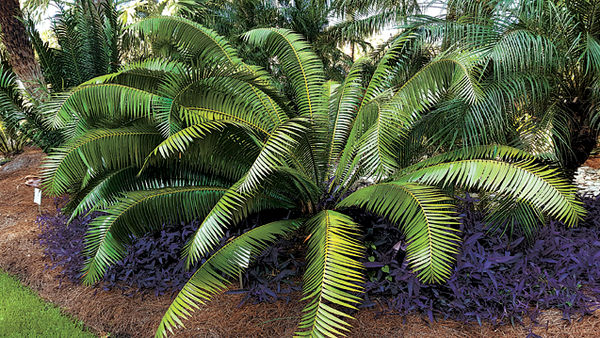Cycadophyta, “cycads”, are an ancient group of tropical and subtropical plants dating back more than 200 million years ago, from the time of the dinosaur age. While they dominated the landscape then, they are now becoming endangered. Often mistaken for palms, cycads are gymnosperms (naked seeded), meaning their unfertilized seeds are open to the air to be directly fertilized by pollination. The leaves grow directly from the trunk and fall off as the plant ages leaving a crown of leaves at the top. Research shows there may be over 200 species of cycads and more are still being discovered.
While there are hundreds of different species of cycads, there is one type, the dioon (dioon educe), that does well in zones eight to 11. This cycad has stiff, upright leaves that are almost blue-green in color. While the leaves look feathery in appearance, they are actually rather spiny. The dioon is a good alternative for the popular sago palms that were planted for decades, but which are very susceptible to scale. This plant can produce multiple trunks and can grow up to eight feet tall, though it is very slow growing. This plant can work well as a specimen or a more architectural background plant and lends a modern edge in the landscape compared to the older varieties of sago.
Cycads are great for beginner gardeners as they are very easy to maintain. It is a very hardy, slow growing evergreen and can be grown indoors or outdoors. They are not picky about the type of soil they are planted in, but the soil should be kept moist and not over watered. The most important thing to remember is to make sure they have adequate drainage as they will not thrive in very wet soil. This type of dioon prefers full sun to partial shade and its high tolerance for salt makes it a perfect fit for our island environment. Enjoy this ancient plant in your landscape.
This column is a joint effort by all at In The Garden, Sanibel Island’s garden center, located at 3889 Sanibel Captiva Road, Sanibel Island.
